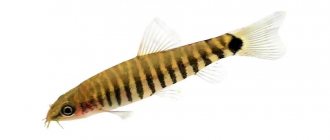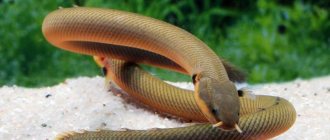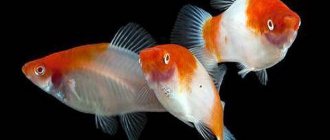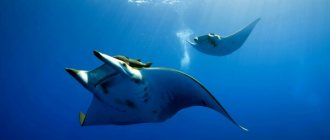Ocellated astronotus or Oscar (lat. Astronotus ocellatus, English oscar fish) is a large and brightly colored freshwater cichlid from South America. One of the most popular aquarium fish of the cichlid family. This is a large, aggressive, but very smart fish. From the article you will learn what types of astronotus there are, how to keep an Oscar, feed it, choose aquarium mates and breed it.
Origin and description
Astronotus
lives in the Amazon River basin and in the upper tributaries of the Paraguay and Paran. It was first brought to our country 60 years ago. Despite its impressive size, this fish arouses wild interest and great love among many aquarists.
The body shape of the astronotus is elongated in length and flattened on the sides. The head is large with a convex forehead and large expressive eyes.
The fish has large, rounded dorsal and anal fins. At the moment, many multi-colored variations of astronotus have been created. The most common in aquariums are: natural color, copper and albino variant with a milky white background and a red pattern on it. Sexual differences in males and females are not pronounced.
They become noticeable only during the spawning period. During this period, the female has a large ovipositor, and the males have a small vas deferens. In nature, astronotus can grow up to 40 cm in length. In this case, body weight can reach 2 kg. In aquariums they grow no more than 25 cm. Life expectancy is quite high; under good conditions, astronotus can live in an aquarium for up to 20 years. During this time, he becomes not just a beloved pet, but a real member of the family!
Habitat in nature
The species was described by Louis Agassiz in 1831, given the Latin name Lobotes ocellatus, and later renamed Astronotus ocellatus. The generic name comes from the Greek words astra (ray) and noton (back), referring to the shape of the dorsal and anal fins. And the word ocellatus is Latin for ocellated, a reference to the characteristic black spot located at the base of the tail, resembling a large eye.
The fish lives in South America: in the east of Venezuela, in Guiana, in the Amazon basin, in the rivers: Rio Negro, Parana, Paraguay. In nature, fish are often found in forested slow-moving or stagnant ponds with a muddy bottom, where they stay close to the roots of flooded trees under the cover of surface plants. It feeds on fish, crayfish, worms and insects.
The fish was accidentally introduced to China, Australia, and Florida, where it quickly acclimatized and began hunting local fish species, leading them to complete extinction. In their natural habitat, fish are considered a valuable source of protein.
Astronotuses first appeared in Europe in 1937. They have gained popularity among aquarists due to their bright color, large size, and behavioral characteristics - they quickly get used to the owner, recognize him and even allow him to be petted.
Appearance
Astronotus is a large cichlid, in nature growing up to 45 cm (and weighing up to 1.5 kg). The size of aquarium specimens depends on the volume in which they are kept, but is usually a little more modest - 25-30 cm.
The fish has an oval, laterally compressed body. The fins are large, somewhat elongated. The anal and dorsal fin are practically connected to the tail, creating a kind of “fan”. The caudal fin is rounded.
The head is large, pointed, the forehead line is convex. The mouth is terminal, the lips are fleshy, and there are small teeth in the mouth. All these signs give us a typical predator.
The main body color is dark, almost black, with unevenly distributed red-orange spots. Sometimes they are arranged in almost vertical lines, reminiscent of the color of a tiger, which is why the fish got one of its names. At the base of the tail there is a black spot bordered by an orange stripe.
Interestingly, juvenile astronotus differ significantly in color from adults. Their spots are not red-orange, but white. These contrasting colors look very attractive. Sexual dimorphism is not expressed. Nowadays, several breeding forms have been obtained that differ in color and body shape.
Astronotuses are long-lived aquarium plants. In suitable conditions, fish can live up to 15 years.
Conditions of detention
If an astronotus lives in your house, keeping the pond clean is quite difficult. A purchased external biofilter will be a good helper for you. It will successfully clean the aquarium of ammonia that accumulates in the water, and also a large catfish that will happily feast on the leftover food of its neighbors. Astronotuses are very sensitive to lack of oxygen, so pay special attention to aeration and water filtration.
It is enough to change a third of the water once a week to keep your fish in good health. Astronotuses do not tolerate cold water well. To prevent your pets from getting sick, maintain the water temperature in the aquarium within 23 -27°C.
Feed your cichlids pieces of live or frozen fish or small live fish a couple of times a day. Astronotus is a big eater and, in order not to overfeed it, give it as much food as it can eat in two minutes. You can even arrange fasting days. Like all predators, astronotus like raw meat, beef liver and heart.
They eat squid, tadpoles and snails, earthworms, as well as bloodworms, flies and grasshoppers. If you do not have the opportunity to purchase animal food, you can feed astronotus with special food for cyclids. Some fish lovers prepare food for future use and store it chopped in the freezer.
Feeding the Astronotus
The natural diet of astronotus includes small fish, insects, worms, and algae. This species is a predator, so the fish must be fed a large amount of high-quality animal proteins.
Among aquarists, it is often practiced to feed astronotus with fish, ground beef, earthworms, and even dry cat food. It is strictly not recommended to feed Oscars meat from warm-blooded animals (beef). This is due to the fact that fish do not have suitable enzymes to digest these meat products. This practice also leads to obesity and degeneration of internal organs. Any invertebrates caught in nature (earthworms, crickets) can pose a risk of infecting your fish with infections and parasites. They also pollute the aquarium heavily, which can be dangerous when keeping fish of this size. Finally, all of these foods are exclusively protein foods and do not take into account the fish’s need for other nutrients.
Therefore, when feeding astronotus, it is better to focus on high-quality dry food for cichlids, for example, the Tetra Cichlid line.
The advantage of these feeds is obvious: they are rich in high-quality proteins, fully balanced, and contain essential vitamins and minerals. At the same time, they are absolutely safe, convenient to store and give to fish.
The food is selected depending on the size of the fish.
Tetra Cichlid (XL) Sticks are ideal food for adult Astronotus. The sticks float on the surface of the water and, due to their shape, take the form of natural food for large fish, while fully meeting the needs of the cichlid body for protein consumption.
To enhance the color of bright spots on the body of the fish, you can use Tetra Cichlid Color food in the form of balls with a concentrate of natural carotenoids.
For small astronotuses, we recommend small Tetra Cichlid Granules or Tetra Cichlid XL Flakes for all types of cichlids.
Astronotuses are prone to overeating, so once a week the fish need a “fasting” day.
Reviews
I’ve been interested in aquariums for a long time and finally decided to buy a couple of astronotuses. The fish have very interesting behavior and, in principle, are not difficult to care for if you immediately set up an aquarium with everything you need. Victor, 52, Ekaterinburg
I have long wanted to try keeping astronotuses and, having moved to a new house, I was able to set up a large aquarium with these beauties. I bought an adult pair from an ad. At first the fish were stressed because of the move, but then they got used to it. It is very interesting to watch such pets. They are already trying to get a divorce, but I don’t know yet what will come of it. I have never regretted having such an aquarium, although I have to constantly tinker with live food. Margarita
Sex differences
It is quite difficult to distinguish a male from a female. However, males are larger than females, have longer and more pointed fins, and the eye spot at the base of the tail is more clearly defined. Females tend to have brighter colors. Clear differences appear during spawning: males develop a cone-shaped vas deferens; females have a trapezoidal ovipositor. Keeping astronotuses is not that difficult, the main thing is to provide the individuals with sufficient space with good quality water; and of course, choose your neighbors wisely. But in return you will get smart and beautiful fish.
Breeding
To breed Astrontus, a group of 4-5 young fish is placed in a separate aquarium.
They form pairs, and the best one is taken to spawn. Astronotuses become sexually mature at 2 years of age. It must be taken into account that, despite their size, these fish are shy; they react cowardly to noise, which should not occur during the spawning period. It should take place in another spawning aquarium, since the neighbors will create unnecessary noise and a threat to the offspring of Astronotus. The aquarium must be equipped with aeration and filters. The water in it should be at a temperature of 26-28 degrees, soft. Soil in the spawning tank is not required. You can limit yourself to only a large and flat stone, where the female Astronotus will lay eggs. It should be noted that during spawning the fish change color. Males become very careful, carefully cleaning the surface of the stone. Only after this does spawning begin, lasting 4-5 hours. The female lays about 1000 eggs at a time. Astronotus are prolific fish. Producers carefully care for the offspring (eggs). They fan them with their fins, and simply guard the larvae. A week passes between the transformation of larvae into fry. The young begin to feed on their own.
For the first days, it is recommended to feed it with daphnia and brine shrimp, and then add chopped tubifex to the food. The fry of this fish grow unevenly. For this reason, it is better to sort them. At the age of one month, the size of the fry reaches 2 centimeters.
Reproduction
Breeding these cichlids is not difficult if kept correctly. The pair spawn regularly if the fish are not stressed. There are no externally noticeable sexual differences between males and females. The sex of fish can only be distinguished by their behavior after a pair has formed. They reach sexual maturity at the age of 2 years, when the body size is 10-15 cm. Spawning is stimulated by an increase in water temperature. The female can lay up to 1000 eggs at a time. If fish are stressed after spawning, they are more likely to eat eggs or already hatched fry.
05:29
ASTRONOTHUS. MAINTENANCE AND BREEDING IN THE AQUARIUM
It is common for astronotus to take care of the young. The larvae hatch 3-8 days after spawning. The fry begin to swim independently after 6-11 days. Young fish grow unevenly, and therefore it is necessary to regularly place the fry, sorting them by size, so that large fish do not kill smaller ones. The water in the container where the astronotuses grow is changed daily in a volume of 1/5 of the total.
Compatibility
Maybe someone will object: “How can this be? I have five asters living with other cichlids, and even with Pterygoplichts!?” Yes, of course, you can add large members of the family or other fish to astronotuses that will not allow themselves to be offended. But in this case, you must be prepared for the fact that at one point fights will break out. As a rule, this moment occurs during puberty and during spawning. Astronotus are very aggressive fish. Their temperament and their temperament do not allow them to be kept with other fish. Moreover, they exhibit intraspecific aggression. Therefore, the correct recommendation would be to keep a pair of astronotuses in a separate species aquarium.
Certainly astronotuses are not compatible with small and medium-sized fish. They perceive goldfish as an aperitif snack.
Speaking of compatibility, it should also be said that keeping astronotuses, even with the most rigid-leaved plants, is problematic. As a recommendation, we can advise decorating the aquarium with Anubias , Cryptocorynes , Echinodorus .
Aquarium volumes for astronotus
Many novice aquarists can again object to our opinion - the recommended volume for a pair of astronotuses should be from 500 liters. This volume will be comfortable for them. Of course, astronotus can be found in aquariums of 250 liters or less, but this is not the norm! Such volumes lead to “dragging” of fish, leading to illness and early death. In addition, we must not forget that astronotus are large fish that excrete a lot of waste products, in other words, poop.
Keeping astronotuses in small volumes leads to the accumulation and high concentration of poisons: ammonia, nitrites and nitrates . And as you know, nitrogen and phosphates are the root cause of all aquarium troubles. Therefore, every conscious aquarist should always monitor them and have a set of drop tests on hand, at least for nitrate and phosphate. Fortunately, they have now become inexpensive, there are no problems with their assortment and acquisition. For example, we can in good conscience recommend you the UHE drop tests, , but they are only sold online. In stores in your city - offline, you can find inexpensive Vladox tests .
Varieties
Astronotus is divided into species, among which there are three main ones: tiger, red astronotus and albino species. Based on these main types, new species still appear through crossing, such as lemon, golden and yellow astronotuses. The albino species is also the result of breeding work.
Astronotus has a brindle coloration with crimson or orange spots on a gray body. An albino has red eyes against a white body with red patches.
The breeding work called “astronotus red oscar” is distinguished by its unusual brick-colored body with black fins and is considered one of the most beautiful color variations of astronotus. The red oscar has become famous for its rich red color and this species looks impressive in the aquarium, swimming majestically in it.
The veiled astronotus, which has long beautiful fins, has an unusual and attractive appearance. As a result of breeding work, new breeds were developed, such as the blue and walnut Oscar.
Interesting facts about astronotus
— In Europe, astronotus appeared quite late - in 1934. Asters came to Russia even later - in 1957, and since then they have been extremely popular.
— In the USA, entire farms have been created for their breeding, as it is a popular fish for sport fishing.
— In Brazil, Thailand, and Guinea there are the largest fish farms, which supply astronotus to aquarists from other countries.
Astronotus pair
— Today, there are many forms of astronotus, which differ in color and fin length. For example, there is a popular and beautiful variety of “red oscar”, which was bred in Bangkok: this fish has a dark red color, and part of the back and head is colored greenish-gray, and the fins are edged with black. Based on this species, an albino form was bred, which is considered very expensive. In natural conditions, astronotuses of this color are not found - these are the works of breeders.
Diseases
Despite good health and resistance to diseases, one should be careful and prevent diseases by treating them at an early stage of development. The most dangerous are considered to be infectious diseases such as hexamitosis, accompanied by ulcers on the body and head of the fish. As well as other viral, fungal and parasitic diseases. In such cases, the fish is transplanted into an isolation ward and undergoes treatment, and the common aquarium with decorations is thoroughly disinfected.
Diseases such as obesity, lack of vitamins, gas embolism and stress are considered non-contagious.
HOW TO CARE FOR SCALARIA IN THE AQUARIUM
HOW TO CARE FOR CICHLID FRIENDS?
CYCHLAZOMA MEZONUATE CONTENTS AND DESCRIPTION
Possible diseases
Nature has endowed the tiger astronotus with strong and excellent health. This fish belongs to the category of long-livers, since with proper feeding and favorable conditions of detention, its average life expectancy is about 10-12 years.
But if certain rules of maintenance and feeding are violated, the development of certain diseases is possible:
- Hexamitosis is an erosive injury to the head and lateral lines. It occurs against the background of a deficiency of vitamins and essential nutrients, as well as when living in stagnant, polluted water.
- Parasitic and infectious diseases are also caused by insufficient filtration and aeration, irregular water changes and cleaning of an artificial reservoir.
In addition, against the background of improper care, the likelihood of developing such unpleasant problems as attacks of suffocation, traumatic injuries, stressful conditions, manifested by lack of appetite and exhaustion of the body, increases.
To treat infectious, viral, and parasitic diseases, they use special medications prescribed by a veterinarian, regularly clean the aquarium and change the water, strictly maintaining its optimal parameters, and also increase the percentage of fortified nutritious food in the daily diet.











